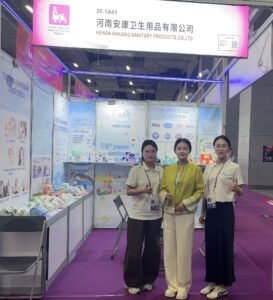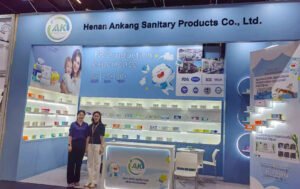Introduction: The Unseen Journey of a Everyday Essential
Have you ever stopped to consider the journey of that seemingly simple wet wipe, from its humble beginnings as raw materials to the convenient, ready-to-use product you hold in your hand? As a leading wet wipes manufacturer, we’re not just creating a product; we’re crafting an essential tool for hygiene, comfort, and convenience that touches countless lives every single day. The process is far more intricate than most imagine, filled with critical junctures where precision and expertise are paramount.
Perhaps you’ve experienced the frustration of a flimsy wipe, or the disappointment of one that dries out too quickly. These seemingly minor inconveniences are, in fact, direct consequences of a manufacturing process that might lack the rigor and attention to detail we pride ourselves on. Our commitment to excellence means we scrutinize every single step, anticipating challenges and ensuring that the final product not only meets but exceeds expectations. This isn’t just about making wet wipes; it’s about delivering a promise of cleanliness and reliability, every single time.
The Genesis: Selecting Our Foundation – Non-Woven Fabric
The heart of every wet wipe lies in its substrate, the non-woven fabric. This isn’t just any cloth; it’s a carefully engineered material designed for absorbency, strength, and softness. Imagine trying to use a wet wipe that tears apart the moment you apply a little pressure, or one that feels like sandpaper against your skin. The experience would be jarring, to say the least. This is why our selection process for non-woven fabric is incredibly rigorous. We source various types, each with unique properties, from trusted suppliers around the globe. Our choice hinges on the intended use of the wet wipe. For example, a baby wipe demands a softer, more gentle fabric, often made from cellulose or cotton blends, to protect delicate skin. Conversely, an industrial cleaning wipe requires a more robust, tear-resistant material, often synthetic fibers, to withstand tougher applications.
We consider factors such as fiber composition, weight (gsm – grams per square meter), tensile strength, and absorbency rates. It’s a meticulous evaluation, almost like an art form, where we’re constantly balancing performance with cost-effectiveness. Sometimes, we even explore innovative blends that offer enhanced features like biodegradability or improved texture. The journey from raw fiber to a coherent non-woven web is a complex one, involving processes like hydroentanglement (where high-pressure water jets entangle fibers) or thermobonding (where heat fuses fibers together). The slightest variation in these processes can significantly impact the final product’s integrity and feel. This initial choice of fabric sets the stage for everything that follows; it’s the foundational decision that dictates the wipe’s ultimate character and effectiveness. Without the right substrate, even the most perfectly formulated liquid would fail to deliver a superior cleaning experience.
The Elixir of Cleanliness: Crafting Our Proprietary Liquid Formulations
While the non-woven fabric provides the body, it’s the liquid formulation that gives the wet wipe its soul – its cleaning power, its moisturizing properties, its scent, and its preservative qualities. This is where our in-house chemists truly shine, acting as modern-day alchemists, meticulously blending ingredients to create solutions that are both effective and safe. Think of it like a master chef creating a signature dish; every ingredient, every measurement, every step in the blending process is crucial. The complexity here can be staggering. For a typical wet wipe, the liquid formulation can consist of dozens of different components, each playing a vital role.
We start with purified water, the primary solvent, which undergoes rigorous filtration to ensure purity. Then, we carefully introduce a range of active ingredients. Surfactants, for instance, are the workhorses of cleaning, breaking down dirt and grease. Emollients and moisturizers, like aloe vera or vitamin E, are added to soothe and protect the skin, especially in personal care wipes. Preservatives are critical to prevent microbial growth and extend shelf life, a challenge that requires balancing efficacy with safety. Fragrances are often incorporated to enhance the user experience, though we also produce fragrance-free options for sensitive individuals. pH balance is another crucial consideration, especially for wipes designed for delicate skin; maintaining a slightly acidic pH mimics the skin’s natural barrier. Every ingredient is sourced from reputable suppliers and undergoes stringent quality checks upon arrival. Our R&D team continuously innovates, developing new formulations that address evolving consumer needs, from antiviral properties to eco-friendly ingredients. The entire blending process takes place in controlled environments, often in large, sterile tanks, ensuring consistency and preventing contamination. It’s a delicate dance between efficacy, stability, and consumer safety, where a seemingly minor adjustment can have profound implications on the final product’s performance and appeal.
The Marriage of Fabric and Liquid: The Converting Process
Once the non-woven fabric is selected and the liquid formulation perfected, the magic truly begins in the converting process. This is where the dry fabric meets its liquid counterpart, transforming into the moist, functional wipe we all recognize. Imagine a large, synchronized ballet, where rolls of fabric unfurl, are precisely cut, saturated, and then meticulously folded and stacked. The scale of this operation can be breathtaking. Giant rolls of non-woven fabric, sometimes weighing hundreds of kilograms, are loaded onto sophisticated machinery. The fabric is then unwound and fed into the saturation station.
Here, the pre-formulated liquid is evenly applied to the fabric, ensuring consistent moisture content across the entire web. This isn’t a simple pour; it’s a precisely controlled process, often involving spray nozzles or roller systems, to achieve the desired level of saturation without oversaturating or leaving dry spots. Too much liquid, and the wipes might be overly wet and messy; too little, and they’ll be ineffective. Finding that perfect balance is key, and it requires constant calibration and monitoring. After saturation, the moistened fabric continues its journey, often passing through a slitting mechanism that cuts it into individual wipes or groups of wipes, depending on the product format. These individual wipes are then expertly folded – often in a “C” fold or “Z” fold pattern – to ensure easy dispensing from the packaging. For pop-up dispensing, the folding mechanism is particularly intricate, designed to ensure that pulling one wipe automatically presents the next. This entire process is highly automated, utilizing advanced sensors and robotics to maintain speed, accuracy, and hygiene.

The Final Presentation: Packaging for Protection and Convenience
The journey doesn’t end once the wipes are moistened and folded. The next crucial step is packaging, which serves multiple vital functions: preserving the wipes’ moisture and integrity, protecting them from contamination, and presenting them attractively to the consumer. Think of it as the ultimate guardian for our carefully crafted product. Our packaging lines are marvels of automation, designed for speed, efficiency, and hygiene. The folded wipes are carefully transferred to packaging machinery, which can handle a variety of formats – from soft flow-wrap packs with resealable labels to rigid plastic tubs with pop-up dispensers, and even individually wrapped sachets for single-use convenience.
The choice of packaging material is critical. For soft packs, we use multi-layered films that provide an excellent barrier against moisture loss and external contaminants. The resealable label or lid is engineered to maintain a tight seal after each use, preventing the wipes from drying out. The sealing process is meticulous, employing heat sealing or ultrasonic sealing to create airtight enclosures. Each package is designed not only for functionality but also for consumer appeal, featuring clear branding, essential product information, and user-friendly opening mechanisms. Lot numbers and expiration dates are printed on each package, providing crucial traceability. Packaging is not merely an aesthetic consideration; it’s an extension of our quality control, ensuring that the wipes arrive at your doorstep in the same pristine condition as they left our factory. A poorly sealed package can render an entire batch of wipes useless, highlighting the critical importance of this final, outward-facing stage.
Guardians of Excellence: Our Unwavering Commitment to Quality Control
Throughout every stage of our wet wipe production process, an invisible yet omnipresent force guides our operations: an unwavering commitment to quality control. This isn’t a single step; it’s an integrated philosophy woven into the very fabric of our manufacturing. Our quality control team ensuring harmony and precision from raw material inspection to the final packaged product. Upon arrival, all raw materials, from non-woven fabrics to individual chemical ingredients, undergo rigorous inspection and testing to ensure they meet our stringent specifications. This includes checking for purity, consistency, and adherence to safety standards. Any material that doesn’t meet our exacting criteria is immediately rejected.
During the blending of liquid formulations, samples are regularly taken and analyzed in our in-house laboratories to verify the precise concentration of active ingredients, pH levels, viscosity, and microbial purity. This ensures that every batch of liquid meets our performance and safety benchmarks. As the fabric is saturated, we conduct real-time checks on moisture content and evenness of saturation. Post-converting, we meticulously inspect the wipes for proper folding, size consistency, and any visual defects. Our packaging lines are equipped with sensors and cameras that detect sealing imperfections, incorrect labeling, or missing components.
Beyond these in-process checks, finished products undergo comprehensive quality assurance testing. This includes shelf-life studies to ensure stability over time, microbial challenge tests to confirm preservative efficacy, and physical performance tests to evaluate tensile strength, absorbency, and dispensing characteristics. We also conduct dermatological testing for personal care wipes to ensure they are hypoallergenic and non-irritating. Our facilities operate under strict Good Manufacturing Practices (GMP) guidelines, and we hold various certifications that attest to our commitment to quality and safety. This multi-layered approach to quality control isn’t just about meeting industry standards; it’s about exceeding them, providing our customers with the absolute assurance that every wet wipe leaving our facility is a product of exceptional quality and reliability.
Innovation and Sustainability: Pushing the Boundaries of Wet Wipe Technology
At our core, we are not just manufacturers; we are innovators. The world of wet wipes is constantly evolving, driven by new scientific discoveries, changing consumer preferences, and an increasing global imperative for sustainability. Imagine relying on the same technology from decades past – it would be like still using a rotary phone in the age of smartphones. Our dedicated research and development team is relentlessly pushing the boundaries of what’s possible, exploring new materials, formulations, and production techniques. We are actively investigating biodegradable and compostable non-woven fabrics derived from sustainable sources, aiming to reduce our environmental footprint significantly. This includes exploring plant-based fibers like bamboo, wood pulp, and even agricultural waste products.
Furthermore, we are developing formulations that are more gentle on the environment, reducing reliance on synthetic ingredients and opting for naturally derived alternatives. This extends to our preservatives and fragrances, seeking solutions that are both effective and eco-conscious. Our commitment to sustainability isn’t just about the product itself; it extends to our manufacturing processes. We continuously invest in energy-efficient machinery, optimize water usage, and implement waste reduction programs throughout our facilities. We explore circular economy principles, looking for ways to reuse or recycle waste materials generated during production.
Beyond sustainability, our innovation also focuses on enhancing product performance and user experience. This includes developing wipes with specialized functions, such as anti-bacterial wipes, wipes for specific skin conditions, or those infused with unique beneficial ingredients. We are constantly seeking ways to improve the texture, strength, and absorbency of our wipes, ensuring they deliver an unparalleled cleaning experience. We listen intently to consumer feedback and track market trends, using these insights to fuel our next generation of products. This relentless pursuit of innovation ensures that we remain at the forefront of the wet wipe industry, offering solutions that not only meet today’s needs but also anticipate tomorrow’s demands.
The Human Element: Our Dedicated Team Behind Every Wipe
While our production process relies heavily on advanced machinery and sophisticated technology, it’s crucial to remember the indispensable human element that underpins every single step. Imagine a finely tuned engine without a skilled mechanic; it simply wouldn’t run. Our dedicated team is the beating heart of our operation, a collective of engineers, chemists, quality control specialists, machine operators, logistics experts, and administrative staff, all working in seamless synergy. Each individual brings a unique set of skills and expertise, united by a shared passion for excellence and a deep understanding of our products.
Our machine operators, for instance, are not simply pressing buttons; they are highly trained professionals who understand the intricate workings of complex machinery, capable of fine-tuning settings, troubleshooting issues, and ensuring optimal performance. Our chemists, as mentioned, are constantly innovating and rigorously testing, acting as the guardians of our liquid formulations. Our quality control team members are meticulous and discerning, with an eagle eye for detail, ensuring that only the highest quality products leave our factory. The human element extends beyond the immediate production floor. Our research and development team, fueled by curiosity and scientific rigor, spends countless hours experimenting and refining. Our logistics team meticulously plans and executes the movement of raw materials and finished goods, ensuring timely delivery.
We foster a culture of continuous learning and improvement, providing ongoing training and development opportunities for all our employees. This empowers them to adapt to new technologies, embrace new challenges, and contribute to our ongoing success. The pride our team takes in their work is palpable; they understand that every wet wipe they help create is a testament to their collective dedication and expertise. It’s this human touch, this unwavering commitment from every individual, that truly elevates our wet wipe production process from a mere industrial operation to a craft, ensuring that every wipe we produce is not just a product, but a promise delivered.
From Our Factory to Your Hand: A Legacy of Trust
From the moment raw fibers arrive at our facility to the sealing of the final package, every step is meticulously planned and executed with an unwavering commitment to quality. We don’t just manufacture wet wipes; we craft solutions for hygiene, convenience, and peace of mind. Every wipe that leaves our factory carries with it a legacy of trust, a testament to our relentless pursuit of excellence and our profound understanding of what it takes to deliver a superior product. We invite you to experience the difference that genuine care, cutting-edge technology, and a passionate team can make.
FAQs
1. What are the primary raw materials used in wet wipe production?
The primary raw materials are non-woven fabric (typically made from fibers like polyester, polypropylene, viscose, or cellulose blends) and a liquid formulation containing purified water, surfactants, moisturizers, preservatives, and sometimes fragrances or other active ingredients.
2. How do you ensure the quality of your wet wipes?
Quality control is integrated throughout our entire process. We conduct rigorous testing on all incoming raw materials, continuous in-process checks on liquid formulations and saturation levels, and comprehensive final product testing for physical performance, microbial purity, and shelf-life stability. Our facilities adhere to strict Good Manufacturing Practices (GMP).
3. Are your wet wipes environmentally friendly?
We are actively committed to sustainability. Our R&D team continuously explores and implements eco-friendly alternatives, including biodegradable and compostable non-woven fabrics and naturally derived liquid ingredients. We also focus on reducing waste and optimizing energy and water usage in our production facilities.
4. Can you produce custom wet wipe formulations or designs?
Yes, as a manufacturer, we often work with clients to develop custom wet wipe formulations, sizes, fabric types, and packaging designs to meet their specific needs and target markets. Our R&D team can assist in creating unique products.
5. What is the typical shelf life of a wet wipe?
The typical shelf life of a wet wipe varies depending on the specific formulation and packaging, but generally ranges from 2 to 3 years when stored properly in its original, unopened packaging. Once opened, it’s recommended to use the wipes within a few months to prevent them from drying out or losing efficacy.





